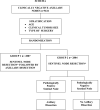Morbidity results from the NSABP B-32 trial comparing sentinel lymph node dissection versus axillary dissection
- PMID: 20648579
- PMCID: PMC3072246
- DOI: 10.1002/jso.21535
Morbidity results from the NSABP B-32 trial comparing sentinel lymph node dissection versus axillary dissection
Abstract
Background and objectives: Three year post-surgical morbidity levels were compared between patients with negative sentinel lymph node dissection alone (SLND) and those with negative sentinel node dissection and negative axillary lymph node dissection (ALND) in the NSABP B-32 trial.
Methods: A total of 1,975 ALND and 2,008 SLND node negative breast cancer patients had shoulder range of motion and arm volumes assessed along with self reports of arm tingling and numbness. Relative shoulder abduction deficits and relative arm volume differences between ipsilateral and contralateral arms were calculated.
Results: Shoulder abduction deficits >or=10% peaked at 1 week for the ALND (75%) and SLND (41%) groups. Arm volume differences >or=10% at 36 months were evident for the ALND (14%) and SLND (8%) groups. Numbness and tingling peaked at 6 months for the ALND (49%, 23%) and SLND (15%, 10%) groups. Logistic regression correlates of residual morbidity included treatment group, age, handedness, tumor size, systemic chemotherapy, and radiation to the axilla.
Conclusions: Although residual morbidity for both treatment groups was evident, the results of the NSABP B-32 study indicate the superiority of the SLND compared to the ALND treatment approach relative to post-surgical morbidity outcomes over a 3-year follow-up period.
(c) 2010 Wiley-Liss, Inc.
Figures
Comment in
-
Sentinel lymph node biopsy in breast cancer: cure and survival are paramount.J Surg Oncol. 2010 Aug 1;102(2):109-10. doi: 10.1002/jso.21568. J Surg Oncol. 2010. PMID: 20648578 No abstract available.
References
-
- Gill G. Sentinel-Lymph-Node-Based Management or Routine Axillary Clearance? One-Year Outcomes of Sentinel Node Biopsy Versus Axillary Clearance (SNAC): A Randomized Controlled Surgical Trial. Ann Surg Oncol. 2009 Feb;16(2):266–75. - PubMed
-
- Del Bianco P, Zavagno G, Burelli P, et al. Morbidity comparison of sentinel lymph node biopsy versus conventional axillary lymph node dissection for breast cancer patients: results of the sentinella-GIVOM Italian randomised clinical trial. Eur J Surg Oncol. 2008 May;34(5):508–13. - PubMed
-
- Mansel RE, Fallowfield L, Kissin M, et al. Randomized multicenter trial of sentinel node biopsy versus standard axillary treatment in operable breast cancer: the ALMANAC Trial. J Natl Cancer Inst. 2006 May 3;98(9):599–609. - PubMed
-
- Fleissig A, Fallowfield LJ, Langridge CI, et al. Post-operative arm morbidity and quality of life. Results of the ALMANAC randomised trial comparing sentinel node biopsy with standard axillary treatment in the management of patients with early breast cancer. Breast Cancer Res Treat. 2006 Feb;95(3):279–93. - PubMed
-
- Purushotham AD, Upponi S, Klevesath MB, et al. Morbidity after sentinel lymph node biopsy in primary breast cancer: results from a randomized controlled trial. J Clin Oncol. 2005 Jul 1;23(19):4312–21. - PubMed
Publication types
MeSH terms
Grants and funding
LinkOut - more resources
Full Text Sources
Medical


